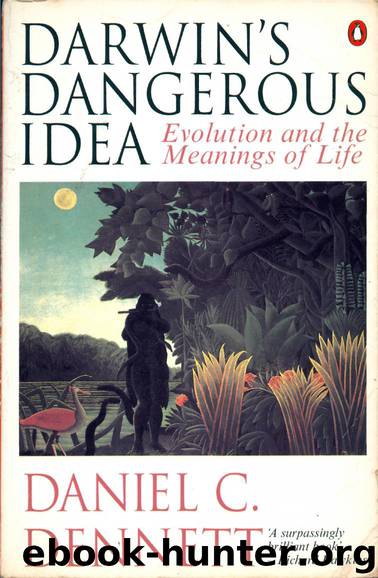Darwin's Dangerous Idea: Evolution and the Meanings of Life by Daniel C. Dennett

Author:Daniel C. Dennett [Dennett, Daniel C.]
Language: eng
Format: epub, mobi
Publisher: Penguin
Published: 2011-01-06T19:08:38.328000+00:00
The tree of life published by Darwin in the Origin (1859, p. 117). The tree depicts a gradualistic pattern of evolution. Each fanlike pattern represents the slow evolutionary divergence of populations. Darwin believed that new species, and eventually new genera and families, formed by this kind of slow divergence. [Stanley 1981.]
FIGURE 10.9
points to the presumed implications for orthodoxy of current research on the evolution of impalas and leopards:
Traditional Darwinism would predict a steady modification of the impala over 3 million years, even without climatic change, because it still needs to outrun leopards. But, in fact, neither impalas nor leopards have changed very much. They are both too versatile to be worried by climatic change, and competition between them and with their own kind does not — as Darwin supposed — provide sufficient selective pressure to cause them to alter. [Tudge 1993, p. 35.]
Tudge's presumption that the discovery of three million years of stasis in the impala and leopard would confound Darwin is a familiar one, but it is an artifact, direct or indirect, of a particular forced reading of the "ramps" in Darwin's (and other orthodox) diagrams.
Gould has proclaimed the death of gradualism, but is he himself, then, a gradualist (but not a constant speedist) after all? His denial that his theory proposes any "violent mechanism" suggests that he is, but it is hard to tell, for on the very same page he says that, according to the theory of punctuated equilibrium, {292}
change does not usually occur by imperceptibly gradual alteration of entire species but rather [emphasis added] by isolation of small populations and their geologically instantaneous transformation into new species. [Gould 1992a, p. 12.]
This passage invites us to believe that evolutionary change could not be both "geologically instantaneous" and "imperceptibly gradual" at the same time. But that is just what evolutionary change must be when there are no saltations. Dawkins dramatizes the point by passing along an eye-opening thought experiment by the evolutionist G. Ledyard Stebbins, who imagines a mouse-sized mammal for which he postulates such a tiny selection pressure in favor of increased size that there would be no increase in size measurable by biologists studying the animal:
As far as the scientist studying evolution on the ground is concerned, then, these animals are not evolving at all. Nevertheless they are evolving, very slowly at a rate given by Stebbins' mathematical assumption, and even at this slow rate, they would eventually reach the size of elephants. How long would this take?... Stebbins calculates that at his assumed very slow rate of evolution, it would take about 12,000 generations.... Assuming a generation time of five years, which is longer than that of a mouse but shorter than that of an elephant, 12,000 generations would occupy about 60,000 years. 60,000 years is too short to be measured by ordinary geological methods of dating the fossil record. As Stebbins says, The origin of a new kind of animal in 100,000 years or less is regarded by paleontologists as "sudden" or "instantaneous".' [Dawkins 1986a, p.
Download
Darwin's Dangerous Idea: Evolution and the Meanings of Life by Daniel C. Dennett.mobi
This site does not store any files on its server. We only index and link to content provided by other sites. Please contact the content providers to delete copyright contents if any and email us, we'll remove relevant links or contents immediately.
The remains of the day by Kazuo Ishiguro(7617)
Tools of Titans by Timothy Ferriss(7017)
The Black Swan by Nassim Nicholas Taleb(6252)
Giovanni's Room by James Baldwin(5956)
Inner Engineering: A Yogi's Guide to Joy by Sadhguru(5942)
The Way of Zen by Alan W. Watts(5841)
The Six Wives Of Henry VIII (WOMEN IN HISTORY) by Fraser Antonia(4824)
The Power of Now: A Guide to Spiritual Enlightenment by Eckhart Tolle(4804)
Astrophysics for People in a Hurry by Neil DeGrasse Tyson(4650)
Asking the Right Questions: A Guide to Critical Thinking by M. Neil Browne & Stuart M. Keeley(4636)
12 Rules for Life by Jordan B. Peterson(3792)
The Ethical Slut by Janet W. Hardy(3544)
Skin in the Game by Nassim Nicholas Taleb(3512)
Housekeeping by Marilynne Robinson(3451)
The Art of Happiness by The Dalai Lama(3417)
Double Down (Diary of a Wimpy Kid Book 11) by Jeff Kinney(3313)
Skin in the Game: Hidden Asymmetries in Daily Life by Nassim Nicholas Taleb(3297)
Walking by Henry David Thoreau(3260)
12 Rules for Life: An Antidote to Chaos by Jordan B. Peterson(3221)
